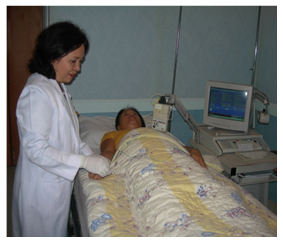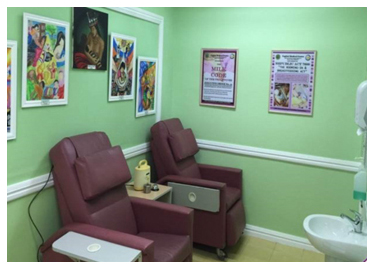- CMC Newsletter - 2015 2nd Edition
- Hits: 2393
CMC Clinical Neurophysiology Laboratory
The CMC Clinical Neurophysiology Laboratory offers sophisticated diagnostic procedures to help neurologists identify neurological conditions and develop treatment plans.
It uses measurement of electrical activity from the central and peripheral nervous system to help in the diagnosis and management of a wide range of neurological conditions in all age groups.
The core investigations are electroencephalography (EEG) and nerve conduction studies (NCS) with electromyography (EMG), which are mostly performed on outpatients and constitute the largest part of clinical neurophysiology workload.

The Electromyography and Nerve Conduction Velocity Studies or EMG – NCS are neurophysiologic examinations that record the electrical activity of the peripheral nervous system and muscles. The procedure is regarded as an extension of the neurological examination. They provide information on the integrity of the peripheral nervous system, neuromuscular junction and muscles. Vital information may be provided that may help determine if a problem involves the nerves or the muscles, or if it is of a more central etiology as from either the brain or spinal cord. More frequently, the EMG study is utilized as an aid in the diagnosis of cervical and lumbosacral radiculopathies, plexopathies and distal neuropathies. It is also very important in the diagnosis of muscle diseases.
 A routine examination consists of two parts, the nerve conduction study which is accomplished by a neurophysiology technician and the electromyography proper performed by a physician electromyographer or neurophysiology consultant. During both procedures the patient will be asked to lie down or sit comfortably depending on what part of the body will be tested. Certain areas of the skin will be cleansed. In NCS, recording and ground electrodes are attached to the skin. A stimulating electrode (stimulator) is held against particular points along the course of the nerve being studied. Low voltage pulses delivered to a specific nerve through the skin is harmless and is tolerated by all patients.
A routine examination consists of two parts, the nerve conduction study which is accomplished by a neurophysiology technician and the electromyography proper performed by a physician electromyographer or neurophysiology consultant. During both procedures the patient will be asked to lie down or sit comfortably depending on what part of the body will be tested. Certain areas of the skin will be cleansed. In NCS, recording and ground electrodes are attached to the skin. A stimulating electrode (stimulator) is held against particular points along the course of the nerve being studied. Low voltage pulses delivered to a specific nerve through the skin is harmless and is tolerated by all patients.
In electromyography, a disposable needle electrode is inserted into a specific muscle which may be felt as a dull ache or pressure. Other electrodes will also be attached to the skin for electrical grounding and reference, they may also be moved to get the readings from different sections of the muscle. The muscle examined will be tested at rest and during contraction. Other muscles are tested depending on the working diagnosis or the presenting symptoms. In the hands of an experienced electromyographer, the examination is generally well tolerated.
 The Electroencephalography (EEG) provides electroneurodiagnostic services for in patients and out-patients both for adults and pediatric cases. Electroneurodiagnostic technology is the scientific field devoted to the recording and study of electrical activity of the brain and nervous system.
The Electroencephalography (EEG) provides electroneurodiagnostic services for in patients and out-patients both for adults and pediatric cases. Electroneurodiagnostic technology is the scientific field devoted to the recording and study of electrical activity of the brain and nervous system.
Electroencephalography (EEG) is a brain wave test. It detects abnormalities in the electrical activity of the brain. This helps diagnose seizure disorders, head injuries, sleep disorders, and causes of unconsciousness.
 EEG is a painless test that records the brain electrical activity through electrodes attached to the head. An EEG does not treat or cure illness, read your mind, give you a shock, or measure your IQ. EEG helps doctors determine if the brain’s electrical activity is causing seizures.
EEG is a painless test that records the brain electrical activity through electrodes attached to the head. An EEG does not treat or cure illness, read your mind, give you a shock, or measure your IQ. EEG helps doctors determine if the brain’s electrical activity is causing seizures.
The CMC Clinical Neurophysiology Laboratory is using the latest technology, with new machines EMG and EEG can be performed more cost effective, in a system that is easy to operate, as well as comprehensive in analysis.
Services:
Electromyography & Nerve Conduction Studies (EMG – NCS)
a. Routine Nerve Conduction, Needle EMG & Conduction Velocity Studies,
b. Facial Stimulation & Blink Reflex Studies,
c. Late Response Studies (e.g. H-reflex, F-waves),
d. Sympathetic Skin Response (SSR) to evaluate small nerve fibers
Special Studies
a. Repetitive Nerve Stimulation (RNS) or Jolly Testing
b. Interventional EMG (Laryngeal EMG)
c. EMG Guided BOTOX Treatment
Evoked Potential Studies
a. Visual Evoked Potential (VEP)
b. Somatosensory Evoked Potential (SSEP)
c. Brainstem Auditory Evoked Potential (BAEP)
The Clinical Neurophysiology Laboratory is located at the 2nd Floor, CMC I Bldg., you may call 3723825 to 44 local 1217. The over-all head of the Neuro Lab is Dr. Emmanuel Eduardo (Neurologist) while the EEG Section Head is Dr. Marissa Lukban (Pediatric Neurologist) and EMG Section Head is Dr. Consuelo Macalalad (Physiatrist).












